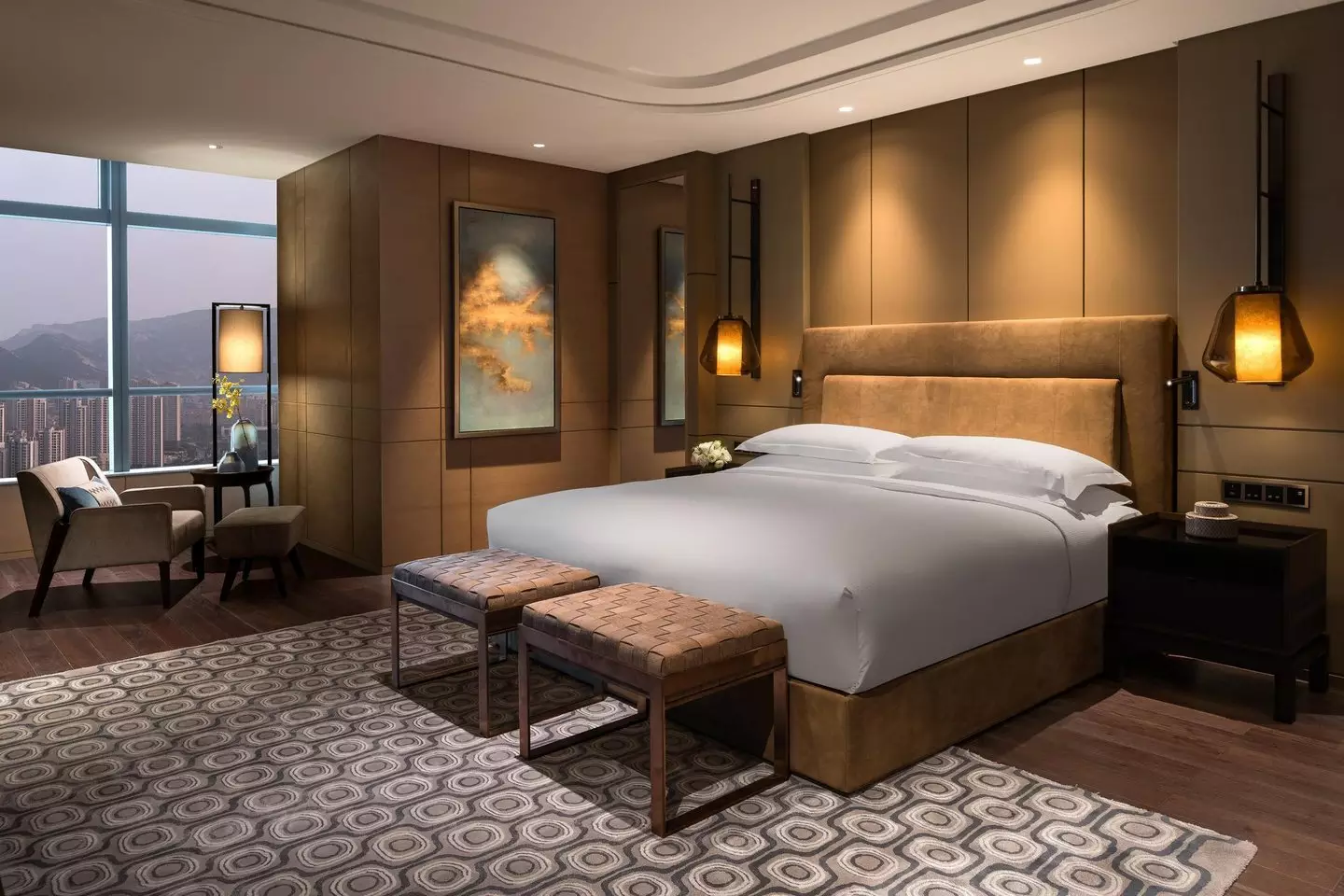Hotel furniture plays a crucial role in shaping the guest experience and conveying a property’s brand image. From the lobby seating that welcomes visitors to the restaurant tables where meals are enjoyed, furniture directly impacts comfort, aesthetics, and ambiance. When sourcing and selecting furniture, hotels must consider factors like design cohesion, durability, maintenance, sustainability, and cost. The furniture should align with the property’s design vision while meeting practical needs. Public area furniture sees heavy use, so it must be able to withstand wear and tear. Furniture styles should complement the architecture and interior design. For example, a contemporary hotel may opt for sleek, minimalist furnishings while a boutique property could feature ornate vintage-inspired pieces. By carefully curating furniture to enhance functionality and guest experience across service areas, hotels can provide stylish, comfortable spaces that support their brand identity.
## Types of Hotel Furniture
One of the most important types of hotel furniture is bedroom furniture. This includes beds, nightstands, dressers, armoires, desks, and other case goods that outfit a hotel guest room.
Beds are arguably the most critical piece of furniture in a hotel room. They must be comfortable, supportive, and inviting. Hotels choose beds in sizes like queen, king, and twin/single to accommodate different guest needs. Platform beds with box springs and mattresses are common, as are upholstered headboards. Some hotels use sofa sleepers or murphy beds as space-saving options too.
Nightstands provide surface space for lamps, alarm clocks, phones, water bottles, and other bedside items. They typically match the rest of the guest room furniture. Some feature built-in charging stations for devices.
Dressers or armoires supply storage for guest clothing and belongings. Drawers allow guests to unpack while staying at the hotel. Top surface space can hold a TV or serve as a work desk. Large armoires with hanging space provide an alternative to closets.
Desks or small tables coupled with office chairs create workstations. These appeal to business travelers needing space for a laptop and papers. The work area might also hold a phone, lamp, charging stations, stationery supplies, etc.
## Lobby and Public Area Furniture
The lobby and public areas of a hotel set the tone for the guest experience. These high-traffic spaces require durable, comfortable, and aesthetically pleasing furniture.
**Reception Desks** – The reception desk is the heart of any hotel lobby. It should reflect the hotel’s brand and style. Common materials include stone, wood, glass, and metal. Modular designs allow flexibility in size and layout. Ergonomic factors like sit-stand options and adjustable monitor mounts promote employee health. Open and inviting reception desk shapes improve guest approachability.
**Lobby Seating** – A variety of lobby seating creates spaces for guests to relax, socialize, or work. Upholstered chairs and couches promote comfort. Durable wood or metal frames withstand heavy use. Cohesive designs and material schemes reinforce brand identity. Movable, modular seating enables reconfiguration.
**Lobby Tables** – Lobby tables suit both solitary guests and small groups. Small end tables with table lamps create cozy reading nooks. Longer tables act as shared workspaces. Coffee tables framed by multiple chairs or couches form conversation areas. Materials like marble, wood, or glass resist spills and scuffs.
**Other Lobby Items** – Rugs, lighting, art, greenery, and accent pieces like ottomans and side tables complete the lobby aesthetic. Well-chosen items reflect the hotel’s style and brand. Durability and easy maintenance are key considerations.
## Restaurant Furniture
Restaurants in hotels require durable and stylish furnishings to accommodate guests. Key furniture pieces to consider include:
**Tables** – Restaurants need a variety of table sizes and shapes to allow for different group sizes and table arrangements. Options like round tables for 2-4 people, square 4 tops, rectangular 6-8 tops, and large round tables that can seat 10+ guests. Materials like wood, laminate, or metal play a role in aesthetics and durability.
**Chairs** – Sturdy, comfortable chairs should match the style of tables. Priority is given to materials like metal or wood that can withstand heavy use. Cushioned seats provide comfort, while seat backs offer support. Armless chairs allow flexibility in seating arrangements.
**Booths** – Booths create an intimate dining experience and allow flexibility in seating larger groups. Typically upholstered bench seats line three sides of a table. Freestanding booths can be arranged in different formations. Booths promote longer stays and are ideal for casual dining restaurants.
**Bar stools** – Stools are essential for outfitting a hotel bar. Adjustable height, foot rails, and backless or low back designs allow flexibility. Padded seats keep guests comfortable, while stable bases withstand active use. Stools should coordinate with the style and finish of the bar.
When selecting restaurant furniture, hotels must balance aesthetics, comfort, and durability to create a welcoming dining experience for guests.
## Outdoor Furniture
Outdoor spaces like poolside lounging areas are important parts of many hotel properties. The right outdoor furniture can enhance a hotel’s ambiance while providing comfort and style.
Poolside lounge chairs made of weather-resistant materials like aluminum, teak, or plastic allow guests to relax in the sunshine without worry. Adjustable chaise loungers with cushions give guests the flexibility to sit up or fully recline. Matching side tables provide space for drinks, books, and other poolside necessities.
Complement lounge chairs with larger outdoor dining tables surrounded by chairs or sectional patio seating. Umbrellas and cabana tents provide shade on sunny days. Many hotels opt for lightweight, portable furniture that can easily be rearranged as needed.
Waterproof, UV-resistant cushions in bright colors or patterns add visual interest while protecting the furniture from sun exposure and wear. Fire pits and other heating elements can extend the use of outdoor spaces into cooler evenings.
Choosing durable, comfortable outdoor furniture tailored to the hotel’s specific climate and aesthetic allows properties to maximize their outdoor spaces as areas for relaxation, dining, events, or activities.
### Banquet and Conference Furniture
Banquet and conference rooms are important revenue generators for hotels. The furniture in these spaces can make a big impact on the guest experience. Here’s an overview of key banquet and conference furniture:
#### Chairs
Banquet chairs are a top consideration. Sturdy stackable chairs with padded seats are ideal for accommodating large groups. Upholstered stacking chairs add elegance for more upscale events. Armless chairs allow more flexibility in seating arrangements. Choose chairs that match the room’s décor.
#### Tables
Banquet tables are available in rounds and rectangles, in various sizes. Standard sizes like 60-inch rounds or 6-foot rectangles allow flexibility in table layouts. Banquet tables should be lightweight and foldable for storage when not in use. Tables with scratch-resistant laminate tops hold up well.
#### Staging and Risers
Staging pieces like risers, dance floors, and movable stages enable customized room setups. Risers with incremental heights allow good visibility for presentations or fashion shows. Portable staging brings versatility for different functions and groups. Sturdy equipment with non-slip surfaces is essential for safety.
## Furniture Materials
Hotel furniture is available in a variety of different materials that are chosen based on aesthetics, durability, maintenance, and cost. Some of the most common materials used for hotel furniture include:
**Metals** – Metals like aluminum, steel, and wrought iron are commonly used for outdoor hotel furniture like tables, chairs, and patio sets since they are lightweight but very durable against weathering and heavy use. Metal furniture can have a sleek, modern look. Wrought iron furniture can provide an elegant, classic look. Metals are also easy to clean.
**Wood** – Hardwoods like oak, maple, teak, and mahogany are frequently used for hotel furniture like beds, dressers, desks, and tables. Wood provides a warm, inviting look and is very strong and durable. More affordable softwoods may be used for some indoor hotel furniture too. Woods can be finished in different stains or paints to achieve different aesthetic looks.
**Fabrics** – Upholstered furniture uses various fabrics like polyester, cotton, linen, leather, and microfiber. Fabrics determine the look, feel, and durability of upholstered furniture like sofas, chairs, headboards, and ottomans. Luxury hotels may use rich fabrics like silk and velvet. Performance fabrics like polyester and microfiber are easy to clean and more budget-friendly. Outdoor fabrics need to be fade and weather resistant.
## Sourcing Hotel Furniture
Hotels need to judiciously select vendors and suppliers for furnishing their properties. Some key considerations when sourcing hotel furniture include:
– **Hotel Needs** – Clearly identify the types of furniture needed for your property based on the size, amenities, and target clientele. This dictates the quantity, quality, size, material and features required.
– **Quality** – Only opt for commercial-grade, durable furniture designed specifically for high traffic hospitality environments. Don’t compromise on quality to save costs.
– **Customization** – Work with vendors to customize furniture to perfectly match your brand identity and aesthetics through fabrics, finishes and more.
– **Eco-Friendly** – Choose environmentally sustainable materials and vendors with green certifications and practices. This appeals to eco-conscious travelers.
– **Cost Analysis** – Compare proposals from multiple vendors based on pricing, payment terms, shipping costs, warranties etc. But don’t make cost the only criteria.
– **Local Suppliers** – Consider reputable local suppliers to save on transporation costs and import duties. They’re also easier to coordinate with for installations and maintenance.
– **Installation & Maintenance** – Ensure the vendor will handle professional installation with minimal disruption. Also confirm they can provide continued maintenance support when required.
– **References & Samples** – Vet potential vendors thoroughly. Ask for client references, visit their factory if possible, and inspect product samples before ordering.
Sourcing furniture smartly from reliable vendors can make furnishing your hotel a smooth and satisfactory endeavor. Partner with suppliers invested in your long-term success.
## Furniture Maintenance
Regular maintenance is crucial for keeping hotel furniture looking its best and maximizing its usable lifetime. This involves daily cleaning, periodic deep cleaning, carrying out repairs, and planning for eventual replacement.
**Cleaning**
Furniture should be dusted daily and inspected for any spills or stains. Fabric upholstery can be vacuumed regularly. Periodic deep cleaning will be required using the appropriate cleaning solutions and techniques for the furniture materials to remove accumulated dirt and grime.
**Repairs**
Hotel staff should regularly inspect furniture for any damage, wear and tear, or mechanical issues. Loose joints, scratched surfaces, fabric tears, and broken parts should be repaired quickly to prevent further deterioration. Maintenance staff should be trained in basic furniture repair techniques. Some repairs like re-upholstering may need professional assistance.
**Replacement Cycle**
No matter how well maintained, furniture will eventually need replacement from continuous use. Public area seating may need replacement every 3-5 years. Casegoods like dressers and desks may last 8-10 years. Developing a replacement plan spreading costs over time is ideal, so furnishing updates happen gradually rather than all at once. When planning replacements, opt for durable commercial-grade furniture designed to withstand heavy hotel use.
## Key Takeaways
– The primary types of furniture in hotels are lobby, restaurant, outdoor, guest room and conference furniture. Each serves a distinct purpose and has unique design considerations.
– Hotels require high quality, durable commercial grade furniture that can withstand heavy daily use. Materials like wood, metal, stone and high-grade plastics are common.
– When purchasing hotel furniture, it’s important to buy from reputable suppliers that offer warranties and can handle large orders. Made-to-order custom furniture ensures the aesthetic matches your hotel’s specific design vision.
– Proper routine maintenance is essential – this includes cleaning, repairing broken pieces promptly, and replacing worn out furniture as needed. Well-kept furniture positively impacts guest experiences.
– Overall, hotel furniture requires careful planning and investment to create spaces that are functional, comfortable and reflect your hotel’s brand image. The furniture plays a key role in delivering quality hospitality.









